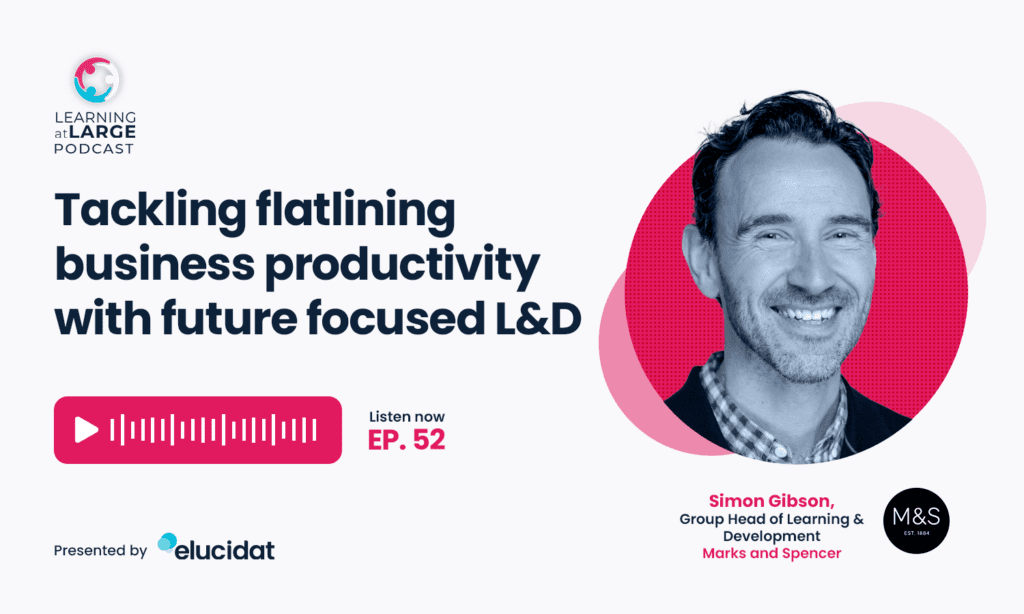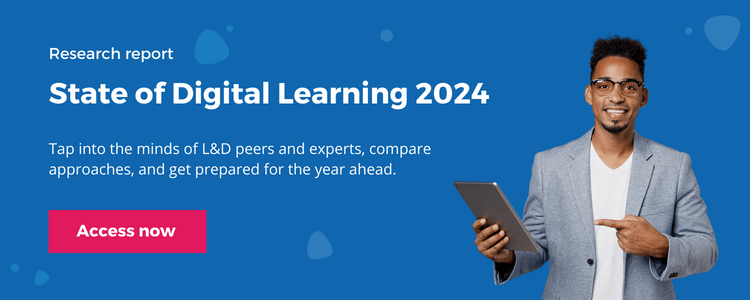Tackling Flatlining Productivity: Simon Gibson
While investment in L&D has steadily risen over the years, business productivity has been flatlining. Hear why Simon Gibson, Group Head of Learning & Development at Marks and Spencer, thinks L&D isn’t having the right impact. Find out how understanding your business and getting future-focused will help you correct this situation and show your value.

Top tips for boosting business productivity with future-focused L&D
Don’t have time to listen now? Here are some top tips from Simon:
- Recognize the problem; Be part of the solution: L&D investment isn’t having the expected impact. Acknowledge this, so you can start to solve the problem.
- Balance today and tomorrow: Meeting today’s needs is critical. But long-term success is only possible if you prepare for future skill gaps.
- Understand your value chain: Get involved in your business. Find out how you make money and identify the pain points. Then explore how L&D can help.
- Capture the evidence: Quantify your key business problems. Try things out. Gather data so you can showcase your impact.
1. Recognize the problem; Be part of the solution
Despite billions being spent on L&D year on year, our productivity level has remained the same. If it’s L&D function to boost performance, when business productivity remains static there’s clearly a problem.
Of course, L&D alone can’t improve efficiency. Outside factors like world events, workplace shifts, changes in customer expectations, as well as internal culture and attitudes have a huge impact. But Simon believes it’s critical that we recognize that L&D is part of the problem so that we can be part of the solution.
“We’ve been spending about £40 billion a year on L&D since 2000. It’s a big number. Globally, the estimated year-on-year is about half a trillion. But productivity has remained the same. So, either we’re wasting money on the wrong things, we haven’t developed the right skills or capability, or we’ve not really understood where we need to put those investments…maybe we’re part of the problem.”
2. Balance today and tomorrow
For Simon, this issue came into sharp focus following the seismic shock of the pandemic. When the world made a rapid move online and to remote work, the skills landscape suddenly shifted. Everyone needed software engineers and data scientists. But these capabilities were hard to find because we just weren’t prepared.
Future capability clearly needs to be part of the L&D conversation. At Marks and Spencer, exceptional customer service skills are key. But if the organization is going to maintain and improve business productivity, Simon knows this can’t be his only focus.
‘’We’ve got to move fast to be able to work in a retail environment. If we put 90% of our energy on today, and only 10% on tomorrow, what’s going to happen when we hit tomorrow? We won’t have made the appropriate bets…I’ve got to put energy on today…whilst also making some bets on tomorrow. So tomorrow doesn’t come and punch us in the face.”
3. Understand your value chain
There’s long been a narrative that the L&D function isn’t commercial enough. When L&D investment doesn’t lead to an increase in labor productivity, it’s difficult to argue this point.
Simon sees a disconnect at the heart of this issue. L&D is often seen as separate, rather than part of the business. If you want to see better results, you need to be more involved. Understand what matters to your company. If you can’t understand and talk to what’s important, then your work won’t create value and improve business productivity.
“Understand your value chain. Understand how your company best makes money. Go find out what those pain points are, that are causing friction or tension in that chain. Go see if a learning thing, a bit of supporting thing, a bit of guidance thing, whatever that thing is, can help.”
4. Capture the evidence
L&D clearly needs to start showcasing its impact in commercial terms. So how do you step up and show your input has a positive impact on the value chain?
Whether you’re talking about meeting specific performance metrics and KPIs or the bigger picture of measuring productivity, it all starts with data. Without evidence, you can create great digital learning and run fantastic training programs but you won’t know if you’re having the right impact.
“Make sure you capture the data and evidence and understand it. Capture the data upfront. Quantify the problem. Test your thing, showcase the potential impacts, then go do it again. It sounds really simplistic, but [otherwise] you’re just playing around the edges, doing nice stuff, keeping your conspiracy going.”
A quick recap
After years of investment without results, L&D need to take a different approach. Simon has four strategies to ensure you’re playing your part to boost productivity.
- Recognize that you are part of the problem so you can start being part of the solution.
- Don’t just think short term. Balance today’s needs with a longer-term focus on future skills and capabilities.
- Get involved with the business and understand your value chain.
- Capture data and evidence so you can showcase your impact.
Want to find out more about how L&D can increase productivity? Check out the full podcast.
About Simon
Simon worked in a wide range of organizations and sectors before joining Marks and Spencer in 2022. As Group Head of Learning & Development, he is responsible for all things L&D including growth, capability, skills and transformation.
You can find out more and get connected with Simon on LinkedIn.
Simon’s reading list
Rather than suggesting specific works, Simon recommends:
- Reading widely: Read about your industry. Follow the press. Look outside your industry to find adjacent data and identify disruptors.
- Creating a conversation: Take the insights you’ve learned and have a conversation with people in your business.
Looking for more reading tips? Check out our book blog.
Learn more from like-minded learning experts
Interested to hear more from Liz as well as other learning experts and your L&D peers? The State of Digital Learning Report is the place where you can tap into the minds of your L&D peers and learning experts, compare approaches, and get prepared for the year ahead.
